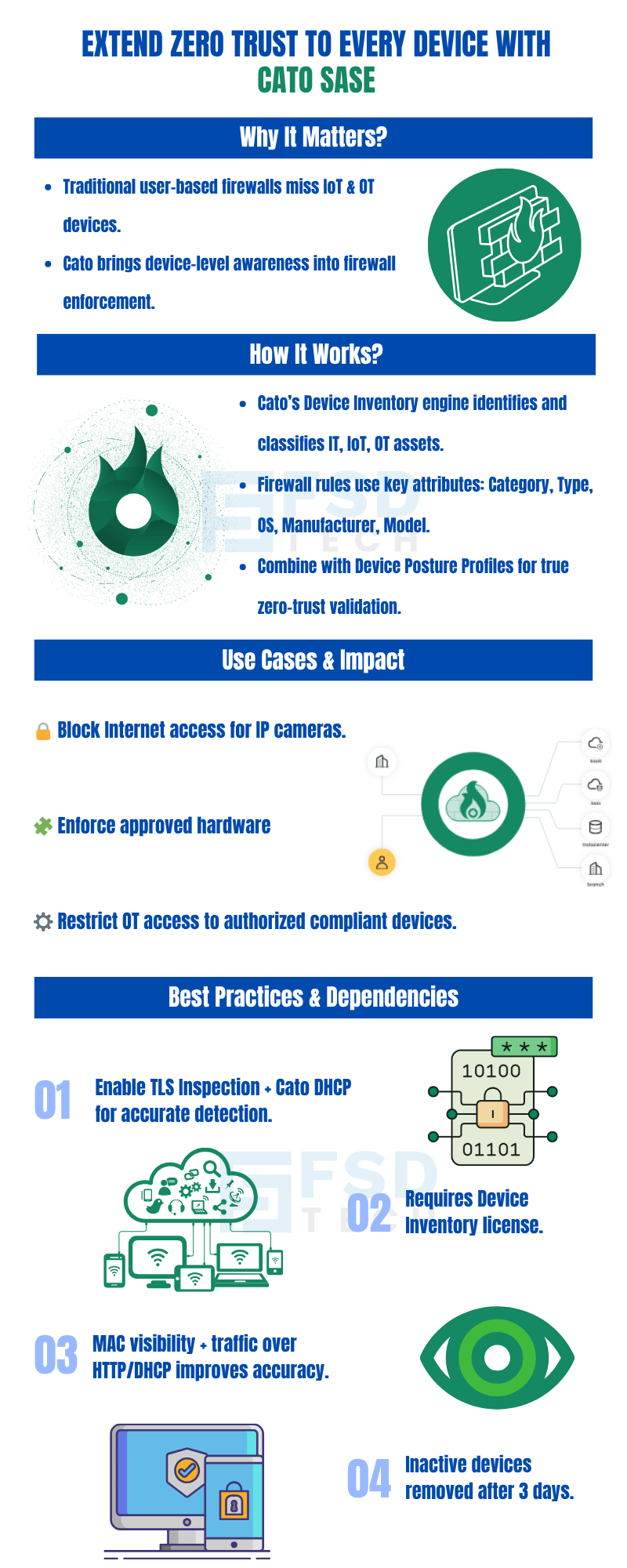
Driving ClickUp Adoption Across Teams: Building Effective Change Programs
🕓 December 7, 2025


Anas is an Expert in Network and Security Infrastructure, With over seven years of industry experience, holding certifications Including CCIE- Enterprise, PCNSE, Cato SASE Expert, and Atera Certified Master. Anas provides his valuable insights and expertise to readers.
Share it with friends!
Modern enterprises face a rapidly growing attack surface driven by IoT, OT, and unmanaged endpoints. Traditional user- or location-based security is no longer enough to enforce zero-trust access.
Cato SASE addresses this challenge by enabling administrators to integrate Device Inventory attributes directly into firewall rules. This feature brings device awareness into both WAN and Internet firewall policies, ensuring that every connection is validated based not only on who the user is, but also what device they are using.
Cato’s Device Inventory engine passively analyzes network traffic using AI/ML to detect, classify, and profile IT, IoT, and OT devices. These device characteristics can then be enforced in firewall policies to achieve granular control.
Supported Device Attributes
Firewall rules can be built on the following device attributes:
To enable this feature, organizations must activate the Device Inventory license, which unlocks the Device Inventory page and attribute-based firewall enforcement.
Cato SASE allows security teams to build multi-layered firewall rules by combining:
The rule logic is as follows:
This ensures administrators can enforce policies that verify not only the type of device but also its real-time security posture.
Cato documentation highlights several practical scenarios:
Integrating Device Attributes into firewall rules provides several advantages:
While powerful, administrators must account for some constraints:
By embedding device awareness into firewall enforcement, Cato SASE strengthens its zero-trust network architecture (ZTNA). Security decisions are no longer made solely on user identity but are contextualized with device type, posture, and compliance status, ensuring least-privilege access across IT, IoT, and OT environments.
If You Need Further Details On How To Implement Device Attribute-Based Firewall Policies Or Strengthen Zero-Trust Architecture In Your Organization, Please Feel Free To Schedule a No-Obligation Requirement-Gathering Virtual Meeting With Our Cato SASE Experts. Schedule Now

Cato SASE allows admins to enforce granular policies on IoT/OT devices by using Device Attributes in firewall rules. For example, Internet firewall rules can block IP cameras from accessing the Internet, while WAN rules can restrict OT devices to authorized users.
Cato supports six key attributes: Category, Type, Manufacturer, Model, OS, and OS Version. These are automatically populated by the Device Inventory engine.
Yes. Administrators can create firewall rules that require both device identity (e.g., Manufacturer = Dell) AND compliance posture (e.g., anti-malware enabled). This layered approach enforces zero-trust verification.
A Device Inventory license is required to access this feature. Without it, the Device Attributes condition will not appear in firewall configuration.
Documented scenarios include:
Yes. Limitations include MAC address dependency, protocol restrictions, data merging/duplication, and device removal after inactivity.
Using Cato DHCP ensures MAC address visibility, while TLS inspection enables deeper traffic analysis for accurate device classification. Both are best practices recommended by Cato.
By combining device identity with posture and user conditions, Cato SASE enforces strict least-privilege policies. This ensures only trusted, compliant devices gain access to corporate resources, a cornerstone of Zero Trust.
share your thoughts